

Oliver's Travels
By Dan
Oliver
(2013-2018)

This is a compilation of Dan Oliver's recollections of working for Games By Apollo, VentureVision, and Atari in the early 1980s.
Apollo
I was 26 when I started at Apollo. When I interviewed with them, I was looking for a part-time job just so I could see what was going on in the industry. Back at North Texas, we were learning about how to make RAM by hand, wire-wrapped, one bit at a time. We'd just gotten a micro lab with Apple IIs, TI, TRS80s... but no one knew much about them. The Apollo gig came up, and it seemed like leading-edge stuff to me. They offered a full-time job and asked how much I wanted to leave college. I'd researched programmer pay for a 4-year degree and knew I'd expect to earn $15k, so I said $16K on the phone. Ed Salvo laughed and said, "We were going to offer you $22K". When I went in to sign the employment agreement, there it was in black & white - $16K. It was clear this was all business, which is perfectly fine with me. But that door swings both ways.
There was some shady stuff, like
stealing info. Apollo had someone from Atari willing to sell a 2600
manual, at least that's the story I was told. I heard they had lunch, and
the guy wanted $100K. There was a lot of paranoia, that we didn't know
about some secret registers that would allow us to do better games. I
remember management asking me if I thought there were unknown registers.
Don't ask me how a person would know about something unknown; I was never in
management. I'd worked at Apollo for a couple of weeks and had already
downloaded and studied at least a few games and figured, if there were any more
registers, we'd find them that way.
Space Cavern
I just read on Wikipedia or someplace that
Pat Roper saw Demon Attack at CES and
gave me a game design without telling me it came from Demon Attack. This came
from an interview with Ed Salvo (Ed.: Ed Salvo claims he was the
person who went
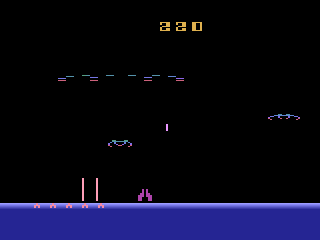 out to CES and saw Demon Attack). OK, so I had like zero knowledge of
what actually went on at Apollo behind closed doors and Ed was in the loop, so he
probably knew a lot more than me. And memory is not a perfect thing. So with
those disclaimers, here's how I remember it...
out to CES and saw Demon Attack). OK, so I had like zero knowledge of
what actually went on at Apollo behind closed doors and Ed was in the loop, so he
probably knew a lot more than me. And memory is not a perfect thing. So with
those disclaimers, here's how I remember it...
My memory is Pat trying to describe Demon Attack and
saying that's the game I should write. He told me he'd seen it at CES and
that everyone thought it was the best game there, mainly because of the
graphics. Maybe he wasn't supposed to tell me he was describing Demon
Attack, but I certainly knew he was describing a game he saw at CES. And a
short time later when he could get a copy, he plunked it on my desk and said
something like, "We need one of these" or, "Make this." He said the copy
was hard to get, and that he'd gotten it from a distributor or something.
He might even h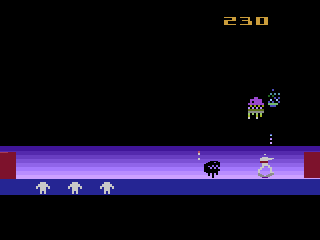 ave
had to return it, but I certainly saw Demon Attack very early. Video games
at the time were a very cloak-and-dagger deal.
ave
had to return it, but I certainly saw Demon Attack very early. Video games
at the time were a very cloak-and-dagger deal.
I downloaded the Demon Attack cart and studied the code; if not Demon
Attack specifically, certainly other games. That's how we learned. Ed had a
manual with the 2600 registers, and he told us a bunch of stuff about vertical
sync, etc, but as I remember it, we learned most of the specific and different techniques from reverse-engineering other games.
They didn't want a knockoff, specifically, they mainly wanted great graphics,
which I obviously came up short on. The Demon Attack bar was pretty high for
someone who'd learned some 6502 only a couple of weeks before.
It took 4 weeks to create Space Cavern, and maybe a few more days. The rush was because they'd
pre-sold
a ton of them already without anyone ever seeing anything. When I started at Apollo, I'd never seen an Atari game, and they had me play some,
and I noticed some of the boxes proclaimed "30 Different Games!", and they were just
changing the background color. I thought that seemed to be important, and Space
Cavern had some absurd number of "games" (Ed.: 48 variations). That
idea of having "lots of stuff" stuck with me. That was my style
back then - throw a
lot of different stuff in and hope something stuck. It became a crutch,
though.
Backups
To get to our office, we walked through the warehouse where they'd set up the
assembly line for the cartridges. It seemed like everyday the line was changed - bigger and with
more people. Skeet Shoot and Spacechase were coming off the line
at that point.
The night I finished Space Cavern, they had the line workers come in to start
production. It was after dark. There were no testers or any testing,
just me
pounding a keyboard and burning EPROMs. I told someone I'd fixed the last bug
(it's easier to declare "last bug" when you don't do any testing). I
backed up the
code and printed a hard copy because that's what they considered to be the
copyrighted material, and I burned the production EPROM. I handed it off and headed home
55 miles away in Denton. I'd been away from home pretty much 24/7 for a month,
so the wife, myself, and a couple of friends went out to celebrate, which we did.
At midnight or something, we we're at a bar and they said I had a phone call.
That's not normal stuff back then. I didn't even know what bar I was in.
It was Apollo. They must have been calling every bar in Denton. I
forget who it was, but they were very nice and told me there's a problem with the game; the bug
wasn't fixed. They had like 15 workers there. I'm too smashed, so I
went home to
sleep a few hours. Next morning, I went in, hung over. It may have been a Saturday, and I
had to walk by the line with all the workers just standing around. No pressure.
I'd screwed up and backed up the wrong source, and lost my fixes. A couple hours later
we were in business, and the line was humming. Crazy. When I sat
down to write Space Cavern in 4 weeks, with only about 3 days of Assembly Language experience and
working on a hardware
platform that we hardly knew anything about, I'm pretty sure most people didn't
think a
cart would fall of the line in 4 weeks.
Ed Salvo
Ed Salvo had come from some real data processing shop and he wore a tie. He thought
all programmers should wear ties. I didn't know crap; I'd dropped out of college
to do this game stuff. So I bought some polyester short sleeve pastel shirts and
some clip-on ties. Ed told me about the clip-on tie thing. He also
always had a pocket protector, but I had no clue where one of those could be
found or what they were even called. Ed didn't tell me to get one, so I didn't.
I thought maybe it was a status thing or something. Looking back now... we
were all "Dilberts".
Larry Minor was a COBOL programmer who wore a 3-piece suit and had just come
from some huge Blue Cross project that had cratered in grand corporate style. Larry would stand around with a ubiquitous coffee cup in his hand and tell us
lots of stories about the Blue Cross project, and about women and about office
politics. Larry first told me that companies expected each programmer to
write a specific number of lines of code per week or something. He was a
character and hopefully still is.
Ernie Runyon
I just read this interview with
Ernie Runyon, which was great.
It's funny how these
things jog my memory. I wasn't sure about the room for reverse-engineering
games, but that seems right. I did take listings back to my desk and studied them.
Ernie said, "I remember Dan had it roughest. I think he may have had a new-born
at home," which made me laugh. I didn't have a new-born at home, but
that sounds like
something I would say. I did have a fairly new wife who was freaking out at all
the hours, and I lived 55 miles away, so travel time didn't help. I remember
talking to her on the phone one night from Apollo, and she was really
upset. This computer stuff was so new then that people just had no frame of
reference. She kind of gave me an ultimatum. I remember looking at my computer
screen and I had to make a choice. What I learned was, never give a person an
ultimatum, which I found useful in my next marriage, which has been great.
Ernie also said, "I also remember coming in late one night to do some coding and
happened upon a co-worker chasing a scantily-clad young lady around the
production line. I was sworn to secrecy." IT HAD TO BE LARRY! Chasing, not
catching - that sounds like Larry.
Wabbit
Apollo hired a bunch of people just
before I left. One was an ex-air traffic controller from the 1981 strike.
I assume he did Final Approach.
While Googling around, I saw Wabbit and the programmer credited is Van
Tran who, if I have the right person, is a
Vietnamese
woman. Our office faced the parking lot and we could see interviewees
parking and walking up. Ban was extremely attractive and when she walked
by, there was a rush into Ed's office begging him to hire her. We kept
walking by his office trying to
crack him up. It's not like anybody there
required any experience, but there was probably very little expectation Ban
would become a
 game
designer because she was not a nerd in any sense of the word. Ban came up
with a game idea really fast - the only one in the new
group I
remember doing so. It was an extremely-intense concept and made Night Trap look
like a bedtime story for kids, but it was 20 years ahead of its time and way too intense
for the VCS. She was explaining it like it was a picnic at the beach, so
pretty quickly the stereotype started to fall.
game
designer because she was not a nerd in any sense of the word. Ban came up
with a game idea really fast - the only one in the new
group I
remember doing so. It was an extremely-intense concept and made Night Trap look
like a bedtime story for kids, but it was 20 years ahead of its time and way too intense
for the VCS. She was explaining it like it was a picnic at the beach, so
pretty quickly the stereotype started to fall.
Lots of people mailed game ideas to Apollo, which we looked through. The idea for Wabbit came from two completely different letters from different people. It was
freaky, because both ideas were almost the same. Ban was given the Wabbit idea,
and her original idea I assume was placed into a time capsule and removed years later,
toned down, and became Grand Theft Auto. She went on to do 5200
stuff at Micro GraphicImage.
Wabbit looks impressive to me considering zero experience and the state of
Apollo at the time, which must have been a mad house with all the new people and
platforms. The player graphic is really good, and female, which also makes me
think Ban is the woman I'm thinking of. In the letters, the players were
male farmers, I believe.
Not too many VCS games were done by women, so that's pretty cool. Ban would have been hired at Apollo
around June
1982, knocked out Wabbit by
July/August 1982, and then jumped to Micro GraphicImage with other Apollo people and had
Solar Fox
ready by September 1983. That's impressive in my book, and her port of Solar Fox was
well reviewed to boot.
Leaving orbit
Right when Space Cavern was released, an article in Forbes
came out about video games and all the money to be made and how game programmers should be considered artists and their
names and images should be on the box. I had been creating and selling oil
paintings before Apollo, so I was kind of aware what an artist was.
Someone brought in the magazine (Larry, I'd bet), and I read it. I set the
magazine down and took off my tie and
threw it in my trash bin. Larry was basically trying to organize us to demand stuff
like credit on the box. The next day, I'm wearing jeans. I'm getting the looks
- not
bad looks but worried looks. Very worried looks. The crap was hitting the fan. I'm
sure Larry had been lobbying Ed, and Ed was talking to Pat. Pretty quickly, like,
that day, they said names on box, no problem, and everyone's salary was doubled.
But at around this same time, Pat was talking about personal helicopters. Not
good. Someone came by to show us the blueprints for the new office complex they
were building, and every office had a fireplace. Not good. We started hiring
"programmers" with the joke being our only interview question was, "Can you spell
6502?" My confidence was not growing.
But the kicker was walking by the production line every day. Now there were
2 or 3 shifts, with like
3 or 4 lines with a cart falling off the end every couple of seconds. Thanks to the article, I knew each plunk was
worth $10. Someone told
me that Space Cavern had pre-sold 75,000 copies. I did some quick math in my
head. I was paid about $1,300 to produce Space Cavern, say 80 hours a week,
so that's about $4 per hour. But yeah, they'd just doubled that, so say $2,600 per
game versus $750,000 on just the pre-sales. That's profit, not revenue. Let's
just say my
mind wandered.
Ernie is right about us not being a tight group. We were all in one, large room with no walls, working 80 hours a week or more, and hardly knew anything about each other. It was just total focusing on the game - not just the code, but the game. You lived in there. Everyone liked everyone, and I certainly enjoyed their company, but we just rarely had free time. After Space Cavern, and after reading the Forbes article about how other game programmers were being treated, I did get to talk to people a bit more, and when I gave my 2 weeks notice, Apollo made me stay, so I basically sat around, so that was nice.
VentureVision

Ad from the May 1983 issue of
Electronic Games
(pg. 99).
I got a newspaper and looked through the want ads. Bingo. "Wanted: Programmer for
video games." I called them up, and he (possibly Robert Hesler) had the start-up money, experience running
companies, and a real desire to sell games. We met an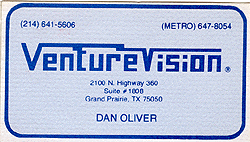 d in his hands was the
Forbes magazine. That was VentureVision. There must have been
20 game companies started that month
from that article. I can't believe that all happened in like 2 months.
It was like a gold rush and very exciting.
d in his hands was the
Forbes magazine. That was VentureVision. There must have been
20 game companies started that month
from that article. I can't believe that all happened in like 2 months.
It was like a gold rush and very exciting.
How VentureVision released games
My 2 partners - really great entrepreneurs, before the term was cool - had
started and run several businesses. All were run very well and they taught
me a lot, but their other businesses were unrelated. They had a used car lot where
they'd buy cars out of the paper, put it on the lot, and charge X but allow Y down
and payments. The Y down covered their cost and they'd get however many
payments they could. They had a countertop repair service in another city.
They'd also just closed down a pretty large custom cabinet shop. Our first meetings
were in the closed cabinet shop. There was a third partner who was
Robert's good friend and partner in all of their businesses, who's name I can't
remember his name (Ed.: Danny Abshire).
So there wasn't really any kind of "plan". Games came out as fast as we could make
them. There may have been some story arc between them, but that would have been done more
after the game was done. It's kind of weird now to think about, but there
were no storyboards or any description at all as far as I
remember. Basically while working on one game, you'd be thinking about the next.
So it was completely in your head. You just sit down and start coding.
Robert Hesler wrote all the backstories for the games, and he tied all 3
games together, but each game was created first and then the backstory was added. The idea for
Innerspace was developed while I was working on Rescue Terra I, and
Solar Defense was
totally Robert Weatherby's creation.
Rescue Terra I
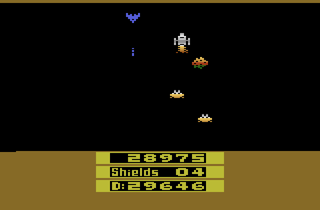
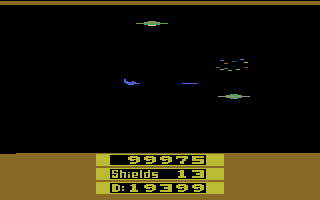

I would have given my left nut to have any of the current VCS homebrew artists to do the packaging for Rescue Terra I. We found a guy who painted really great oil paintings of space nebula-type stuff, but packaging is a different thing, and we probably didn't pay him much. Of course, in the end it didn't matter. The difference, which to me is kind of amazing, is the Internet. Finding an artist in Dallas/Forth Worth was really hard, and finding one who could do packaging was just about impossible. Today, with a few clicks, pages of great artists can be found around the world.
We sold about 10 copies of
Rescue Terra I (Ed.: Dan claimed in a 1997 interview 20,000 carts were made and
384 were sold). The irony of a Rescue Terra I selling for more now than pretty much VentureVision's entire gross revenue is not lost on me, but I can always
say, at least it wasn't E.T. Rescue Terra I didn't even make it to the
discount table. Our biggest, and maybe only sale, was to a couple of guys
from South America who stopped by our CES booth at the close and offered
to buy all we had with us - a couple of dozen. I have no idea what they wanted them
for.
My kid brother sold copies door to door. He said he sold all 12 but
never sent us our cut. Kid brothers.
I don't know what Bob did with the rest of them. I remember we spent a lot of
time putting carts together and boxing them. When you have programmers boxing
carts instead of writing code, you know things aren't good.
We had "sold" 10,000 carts to a distributor and we ordered the ROMs, which took a
few weeks. When we called the distributor back, the guy no longer worked there;
they were out of the games business. That was the crash. This was
the third week of
October 1983. We knew the gold rush was over, but we kept trying. I
went to CES in January 1983 and saw Pat
Roper in the Apollo "booth" which was just a big, empty space with a
couple of folding chairs in the middle with Pat sitting there. I guess he was trying
to sell off whatever he could. It was not a happy time, but Bob did teach me to play
craps, and he was good at it.
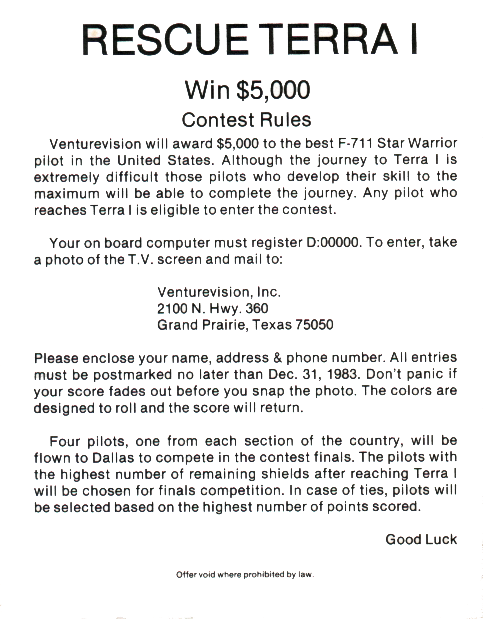 At one point we hooked up with some multi-level marketing people and they seemed
pretty interested, in the same way sharks are interested in things splashing around
in the water. After a bit, they became more interested in an application
program to help
them track all the money. Apparently those things sell fast, but not for too long. They had stories of garbage cans full of letters, checks, and cash that they
couldn't get through fast enough. No computers - they had to doing everything by
hand. A $10 sale meant $1 went to one person, $0.50 to another, and on and on,
like 7-10 cuts for every sale. It was a nightmare. A lot of those guys went to
jail and multi-level marketing was outlawed only because they just couldn't do
the accounting if a product sold a lot. They didn't pay people because they
couldn't figure out how much and to who.
So they wanted me to write an Apple II app, which I did. It was pretty simple,
but then
they wanted to put me into hotels and keep moving me around while their scheme
played out. They said it was common in their business so that law enforcement
couldn't find them. Apparently it was kind of up in the air as to whether or not
these things are legal or not. It depends on how many levels deep and whether the
product is real or not. Selling a 5 cent pen for $100 would be illegal, but
they thought selling a $50 Rescue Terra I would be legal... probably... in most
states, but why take the chance? Let us put you into a hotel? Thanks, but no
thanks, boys.
At one point we hooked up with some multi-level marketing people and they seemed
pretty interested, in the same way sharks are interested in things splashing around
in the water. After a bit, they became more interested in an application
program to help
them track all the money. Apparently those things sell fast, but not for too long. They had stories of garbage cans full of letters, checks, and cash that they
couldn't get through fast enough. No computers - they had to doing everything by
hand. A $10 sale meant $1 went to one person, $0.50 to another, and on and on,
like 7-10 cuts for every sale. It was a nightmare. A lot of those guys went to
jail and multi-level marketing was outlawed only because they just couldn't do
the accounting if a product sold a lot. They didn't pay people because they
couldn't figure out how much and to who.
So they wanted me to write an Apple II app, which I did. It was pretty simple,
but then
they wanted to put me into hotels and keep moving me around while their scheme
played out. They said it was common in their business so that law enforcement
couldn't find them. Apparently it was kind of up in the air as to whether or not
these things are legal or not. It depends on how many levels deep and whether the
product is real or not. Selling a 5 cent pen for $100 would be illegal, but
they thought selling a $50 Rescue Terra I would be legal... probably... in most
states, but why take the chance? Let us put you into a hotel? Thanks, but no
thanks, boys.
I'd never heard of programmers not getting paid back then. In those days, game
programmers were treated very well, I thought. If you weren't, you'd just go next
door or start your own company.
Contest
I'm pretty sure Bob Hesler came up with the idea to promote the game
with the contest. He was a serious game player and played the heck out of Rescue
Terra I. I just found one of the contest fliers, and after reading it, it's a lot more
involved than I'd remembered. I thought it was just whoever had set the high
score first would collect the prize. I'd forgotten (conveniently) there was
suppose to a drawing and flying people around, etc.
My memory is Bob saying something like, "Don't worry, no one is ever going to
reach Terra I" in response to his partner not wanting to do the contest. It
couldn't have been a week later, and we got a few screen photos of people at
Terra I, and Bob was real quiet. You had to know that this money was coming right
out of Bob's pocket, and Bob was no millionaire by any means. Until now, I'd
always hoped that first photo was paid as the winner, but now looking at the
rules, there was no drawing, no flying of anyone to Dallas, and no local
competition. I know Bob would have loved for the game to have sold well enough
to have had the contest. He was/is very honest as was his partner.
We were off (with the release) by maybe 2 weeks. Had 10,000 sold, which would have been maybe $50k
clear, it would have been enough for the contest.
So now I'd have to consider the contest a sham, I'm ashamed to say.
Innerspace inspiration
There was a game I was "inspired" by called Caverns of Mars for the Atari 800. Apollo bought a few
games for us to play. We programmed on an 800, so that must have been where I saw
it. I thought Caverns was really fun.
So there was a connection between Rescue Terra I and Innerspace, but mainly it
was I liked space shooters. Like
most of my games, it was very derivative. I also liked the look of arcade
Defender,
but never really played it. And vertical scrolling games on the VCS were so boring to me,
but of course the 2600 made vertical scrolling easier.
I was driven mainly by graphics. My background had been fine art painting and
such. The thing I'm most proud of for example is that the explosions in
Innerspace are not exactly sprites. Normally you'd have say 3 or 4 hard-coded
explosion shapes in ROM and just animate them. For Innerspace, I created each
explosion "sprite" at runtime in RAM. Each explosion particle had its own
"physics" (6502 128 byte RAM physics, mind you), but I thought it was cool.
I used
the same concept in Final Legacy and some other stuff. As far as I know, no one
else ever did that in a VCS game, but it's possible. And because the sprite
image was in RAM, I put it just above the stack so I could use PLA, which was a
faster instruction than LDA, so I had an edge there I thought. All VCS
programmers were always in search of some magic combination of
hardware registers or instructions that would give us an edge.
Innerspace / Laser Gates
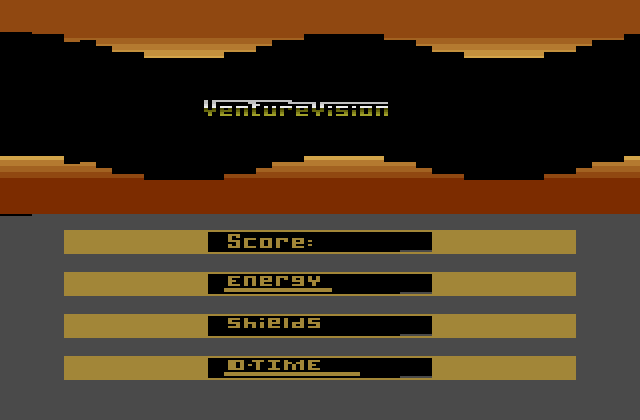
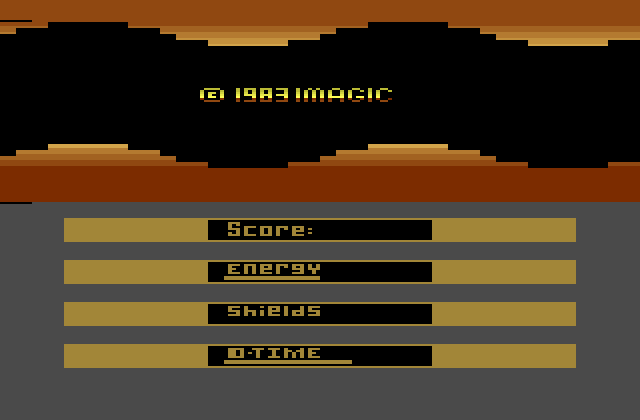
Innerspace was the title at VentureVision. I was nearing completion
of it when VentureVision ran out of money. I was one of 3 owners and we hadn't been taking
much of a salary, so I had no savings and had to leave the company while the
other 2 guys, business guys, closed down. I traded Innerspace for my part of
the company.
I got the game to Imagic, but I don't remember how. They bought it. When I went into
their office building to sign the papers, I spoke to a single suit. The
entire office building was a ghost town; Imagic was shutting down. He showed me the
game running on a TV and explained they'd changed the name and fixed some bugs. I remember him saying 4 bugs, but
I'm not sure. For sure I had a bug in the lower-left side of the screen where one scanline was late, so you'd see like a 1/2"
black scanline, which was common on VCS games. I was very impressed because it was a bug I
had tried to fix and didn't, and they did this without the source code - they just downloaded it,
disassembled it, and made changes. To me, Imagic
had always been tops, right behind Activision, so it was a great compliment that one of
their engineers had worked on my code.
I'd "complimented" them earlier by disassembling Demon Attack when writing
Space
Cavern.
The Imagic guy gave me a check for the advance on the royalties, and told me they were buying the game
to fulfill contract requirements. I thought, hey, you're making my head swell. I turned over
the source code, picked up the check, and started to leave, and the guy said, "Hey, don't
you want to know how to get your future royalty checks?" Not really, dude. I
don't know if this guy actually still thought VCS games were going to be around
in a month, or was just going through the motions. Laser Gates went right
to the discount tables.
So, to me Innerspace and Laser Gates were the same game. But from a collector's
point of view, they'd have to be different games. There were some minor changes to
the Laser Gates ROM, but changes nonetheless. There were no changes to gameplay that I know
of. VentureVision never released Innerspace and I'm pretty sure there was
never a box or manual for it.
Solar Defense
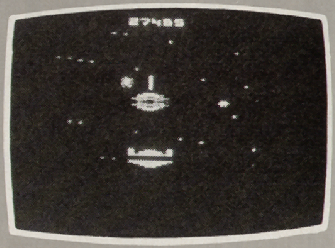
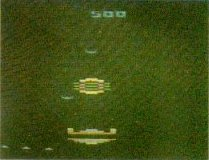
I don't remember the name, but the screenshots posted
are of a
real game and it may have well been called Solar Defense. I can't believe people
know about this stuff. I had to really think a while to remember.
Solar Defense was created and programmed by a really good, natural programmer
named Robert Weatherby. He barely had any programming experience, but
without hardly any programming manual and probably 10 minutes of instruction
from me, he had a game up on the VCS in a couple of weeks. He 'got it' from the get go.
He was just out of college with a degree in music. He was way
into music and audio. According to his LinkedIn page he stayed in games
so, good for him. Solar Defense would
have been 100% his design and implementation.
I'm ashamed to say I don't think I liked Solar Defense much as I remember, but
that really means nothing, as I only liked shooters. My motto was, if it wasn't a shooter,
it wasn't good. But to Robert's credit, he had a vision for a game
and went for it. To me that's a game developer. I left before it was completed,
but it seemed pretty darn cool. It used paddles and
supported up to 4 players. It was maybe a bit like Breakout, or an inside-out
Warlords, and probably had great audio. I don't know what happen to the game after that. Certainly VentureVision
couldn't have released it, as they had 0 cash. Hopefully they gave the rights
for it to Robert.
It'd sure be cool to play it now, finished or not. It was definitely at least
playable the last time I saw it.
Things like
PLA instructions I remember 30 years later. Robert Weatherby's name and the names of my business
partners... not so much. That kind of says it all.
Final venture
I wish that VentureVision deal could
have worked out better, but we were a year too late to the party. You hear about entrepreneurs and I've met many,
but these two guys were the real
deal. They put it all on the line, and they pulled a lot off. They had zero
experience with this type of stuff, and they were getting press, suppliers,
and manufacturing, and even got us to CES.
Atari
After VentureVision folded and I sold Innerspace to Imagic, I was still living
in a trailer in Denton TX because I'd been going to North Texas State on the GI
bill. It was time to look for a job, so
I looked through the game magazines and found a bunch of companies looking for
programmers. This was kind of the apex of companies looking for people, just
before the crash. All the companies seemed to be in CA. I interviewed with a
bunch; the smaller the company, the faster they responded to getting a resume. It was very wild, with all kinds of companies and all kinds of people.
After a few weeks, I was about to accept a job in Sacramento for a
company doing desktop computer games on floppies, when Atari called. I
went out and interviewed with
Chris Horseman, who I thought was younger than me; he was the youngest VP ever at Atari, of which he was very proud and rightly so. He
was
talking a mile a minute about coming from Thorn EMI, and about his submarine game. He
said he was starting an Advanced Games group at Atari that will have maybe 10 of
the best developers in the world. He said he was talking to the dude that wrote
Star Raiders (Ed.: Douglas Neubauer), which dropped my jaw because that's a mythic game. I assumed at the
time that the creator of Star Raiders didn't work at Atari. I'm not really understanding why Chris
was telling me all this
(Space
Cavern is not even in the same zip code as Star Raiders). Chris then said
something like, "Obviously you're not of that caliber.."... which sent me back to reality, "but
we're willing to take a chance on a couple of programmers that we think we could
teach." Sign me the F up! I couldn't believe my luck.
First day at work and it's me, Chris, and Ritta (?), who was Chris's secretary (personal
assistant). Chris was pretty new to Atari, but would never let on. Ritta actually
knew everything. She took me to a huge filing cabinet and flung open the doors,
and this thing was packed. She said, "Take whatever you want, and if there's
anything else you want, just let me know and I'll get it." She said "want", not
"need", and the way she said it, I got the impression if I asked for a lap dance
from William Shatner that Ritta would make it happen in a single phone call.
I was given tours of other groups to see their games, and it seemed like they had
tons of concepts and prototypes. I remember seeing a pretty good (graphically,
anyways) fighting game like Mortal Kombat. I remember thinking, and probably
saying, "That kind of game will never be popular". I sure had my finger on the
pulse of the future. If it wasn't a shooter, it wasn't a game. I still don't get
fighting games. I can go down to the corner bar and get into a fight - very
realistic, with excellent audio. Spaceship blasting creatures? Now that's cool.
There were only three things missing from the Advanced Games Group:
1. Group
2.
Advanced
3. Games
I was kind of waiting for the 'A' team to show up and start
showing me their secrets, and then tell me their lunch orders, of course. But Chris
wasn't interviewing anyone I could see. I started thinking about Final Legacy and
studying the Atari 800 internals. I assume the idea of the sea theme came from
Chris; he may have been trying to get me to make a certain game, I don't know.
I did know it didn't work that way. You can't spec a game. It has to
come from the individual.
I pretty quickly figured out why I'd been hired into the Advanced Games
Group - they couldn't find anyone else! A VP must have at least one employee
other than a personal assistant. I think that's a rule. The next hire was a
hardware guy who knew nothing about games, and didn't really want to know anything
about games, but he needed a job to stay in the U.S. He was from England, like
Chris. He was a funny guy in a Blackadder way and did some good work on a
Last Starfighter arcade game.
Soon after, Chris said the "group" was moving to new offices - a room in a coin-op
warehouse in the middle of nowhere. Forklifts, trucks, noise, flumes... the whole
enchilada. I don't know the whole story, but the impression I got was this
was when
Warner announced the first big loss, like $500 million, which was a lot of money
back then. Chris probably saw the crapstorm on the horizon and hid us under a
rock. I'll bet our budget went tiny real fast. Smart move, Chris.
When a company shuts down, which I have a great deal of experience with, it's not
fun. People just obsess and worry, and no work gets done. Out in the warehouse, I
could just program, and that's where I got most of Final Legacy done. We
did move back into a normal building at some point, and the group got one or
two other people - Eric (?) and an artist working on a laserdisc thing or
a music video, using the Twilight Zone song.
As far as I know, Final Legacy was the only game to come out of the Advanced
Games Group and it barely got out.
I don't remember ever doing concepts or prototypes, which is kind of strange now
that I think about it. I do remember doing an hourglass where each grain
of sand had its own physics. I'm talking fake video game-type physics, but
it looked good to me. I don't think it was ever used in a game.
Final Legacy
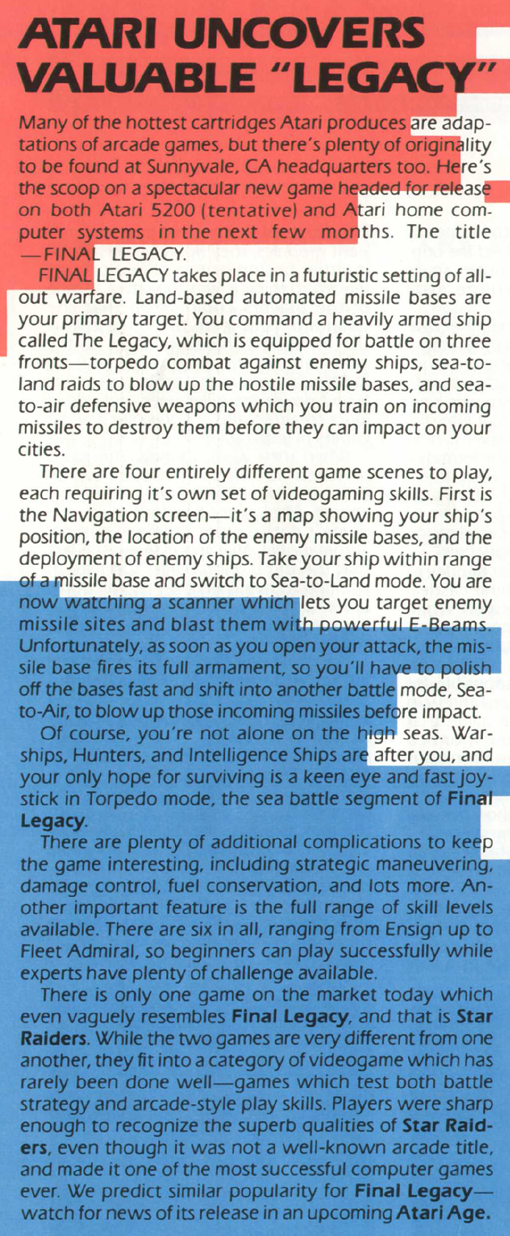
The only mention of Final Legacy in the final
issue of
Atari Age,
March/April 1984 (pg.
13).
Final Legacy was my first chance to have all the time I wanted,
with lots of hardware
resources - no excuses. It was all my design, my programming, and my graphics
(Ed.: Steve Englehart claims he helped work on ideas for the game, and
that the released version is a truncated version of what was originally conceived).
I don't have many Final Legacy stories. It was basically long, hard work.
I have little idea how long it took. I started at Atari in April 1983
according to my resume, and probably started working on it a month or two after
starting at Atari, so I'd say 1 year. I was told the game was in manufacturing when Tramiel took over that July
(1984), and that some number
had been produced (maybe 8,000). I'm pretty sure someone gave me a copy, which was
very nice.
I've always liked post apocalyptic stories - new beginnings, do it right in 2.0
type deals, so the process is knowing what can be
done on the hardware and melting the story idea into that. I kind of
imagine myself inside the computer and everything is black, turned off. I
can see the RAM, the hardware registers, the CPU... and I start turning on stuff
to start building a world. It was fun being able to be in that story for
the 7-12 months Final Legacy took. It's my favorite theme by
far.
I was almost 100% sure Robert Weatherby did the music, but I've since been told Brad Fuller did it. All these years later, the theme song to Star Trek: Next Generation sounds like Final Legacy and it always make me think of Robert (Ed.: The music was reused from Atari's Superman III game, which Brad also did). However, the impression I have is Brad wasn't interested in Final Legacy for whatever reason. I don't think I had a lot of interaction with him, so maybe he just sent me some audio, or maybe only had time for some effects? I'm less than 99.9% sure now who did the music, but I'm 100% sure I had nothing to do with the composition in any way. And I sure would have liked Brad to have done the audio, that's for sure. He was very highly respected as I remember.
Some databases credit Chris for programming and graphics, but I don't remember Chris doing any programming at all on anything (Ed.: The manual credits Chris and Dan for the design, and Dan for the design, programming, and graphics). I remember seeing him trying to program for a day or two on something and asking a lot of questions when we were in the warehouse. I thought he was trying to learn programming because Atari was falling apart at that time. He really looked stressed at the keyboard. After a day or two, he put his suit back on and went back to whatever VPs do. He must have been very good at it because he saved our butts many times. Certainly Final Legacy wouldn't have ever been done without Chris doing all those VP things. I'm sure lots of other people had suggestions that I probably used, but to me, Final Legacy was a kind of test. Am I a game designer? To me, it proved I was never going to be a breakthrough original game designer. Don't get me wrong, I've very proud of my work. I'm not a modest person, but there's a reality. I just couldn't see into the future. I didn't have the vision to do games on the systems that were coming. Maybe I just wasn't that into games, so I didn't have enough source material to steal from. When the ST came along I found what I really liked to do, which was user interface stuff.
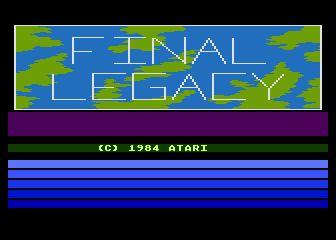
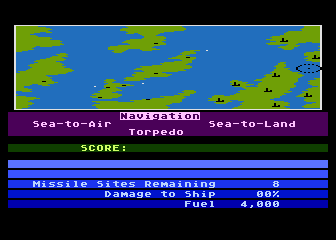
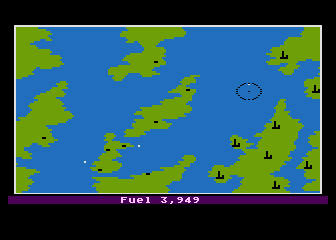
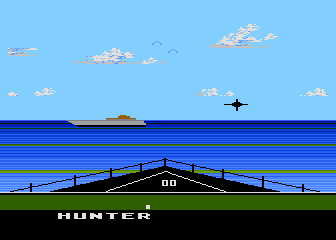
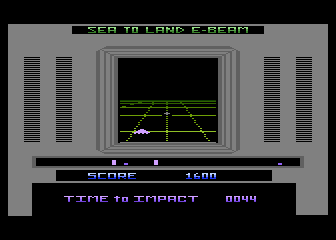
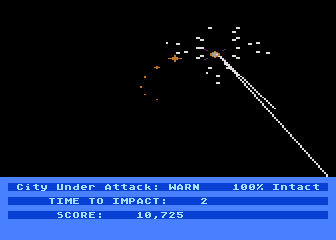
The main map screen was developed first because I was learning about the Atari computer and what it could do. The expanding/collapsing map was a simple trick which I thought was cool. Now when I look at the videos of people playing the game I'm like, "Why didn't I speed that up or have a preference for instant switching?" It looks painfully slow. Just having a instant switch was a bit jarring, so some transition helped, but come on. It's not really an Easter egg, but in the game, the city of Kendall is a tiny town in upstate NY where I grew up.
Regarding the international version, it certainly was a standard thing to use icons to internationalize products, at
least in my little world. It was preferred to localizing text.
I must have had a reason as to why all the versions of the game didn't all use icons because they all went out on
basically the same day, and having all use icons would have been easier. My guess is
selecting the 4 screens could be done in
one joystick move, and the icons were too large for the N-S-E-W layout, so it had to be
a horizontal layout requiring more joystick moves (Ed.: The icons are
selected with one move. From right-to-left, the icons are selected UP,
LEFT, RIGHT, DOWN). I remember really liking the
one-move selection.
With the green grid screen (Ed.: The Sea to Land E-Beam screen), I was trying to steal
from arcade
Battlezone. I loved
that game, and loved vector graphics.
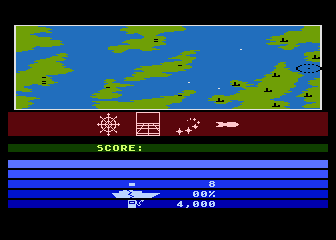
Shooting the incoming missiles was basically stealing from arcade Centipede. I
loved when you lined up on the centipede and just whaled away on the fire button,
blowing it to bits. This screen was also tweaked for the Atari Trak-Ball, which
they were looking for any game to support. The Trak-Ball worked well for the
missiles, as you could get into a rhythm and blow them away like a centipede.
I would have liked to have stolen from Missile Command, too, but I wanted
perspective, and Missile Command really only works in 2D.
The torpedo view was pretty original, at least for me. I was proud of
the clouds scrolling at different speeds, and the light from explosions reflecting
off the clouds. I now wish I would have flashed the white in the clouds when the
user got hit.
Chris Horseman had done a submarine game for Thorn EMI before coming to Atari,
but I'm not sure (Ed.: The only submarine game Thorn EMI released was
Submarine Commander, which was programmed by Dean M. Lock, and Chris
wasn't a programmer as noted earlier). It seemed like he talked about some submarine game a lot,
and made it sound very realistic, which seemed like a good
idea, until you realized being on a sub is pretty boring 99% of the time, which
Chris understood. I wanted more action and didn't let too much reality get in
the way, so the bow of the user's ship is suppose to look like a sub running on
the surface where in theory it could move faster. The torpedoes were gray-colored, to
appear beneath the water.
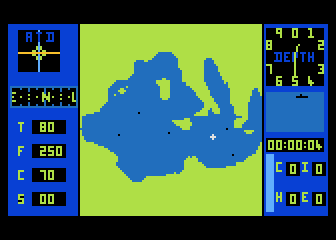
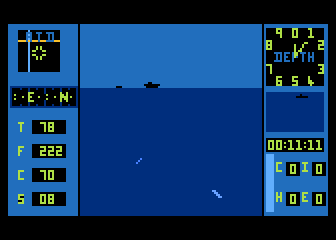
After seeing photos of Thorn EMI's Submarine Commander,
those screens are a lot closer to Final Legacy, especially the map and the periscope screens, so maybe Chris had a lot more input on the design than I remember.
Chris probably wanted Submarine Commander but with more action, and must have showed me the game and
offered a lot of ideas about what game I
should do, at least initially.
I'm sure I came up with the post apocalyptic angle, which to me was the design.
At least
that's my
impression, but when brainstorming, a person isn't always aware where an idea
actually came from - all ideas that you like become your ideas, and all rejected ideas
must have been someone else's. It's not a fair process.
It's strange my earlier prototype carts only
say "Legacy", as I thought "Final Legacy" was
used earlier. I came up with the "Legacy" name pretty much right off, but
I distinctly remember who came up with "Final Legacy". Myself, Chris, and his
friend and Product Manager whose name I can't remember (this was the same PM who
asked me to do Telepathy) (Ed.: Anthony Jones), were talking about the
name. Maybe the PM and Chris had already been talking about this, but there was
some issue with "Legacy" already being used or it was too general a name to clear legal.
Anyway, the
PM came up with Final Legacy, and Chris and I instantly liked it. I guess that
happened later than I remember, after the focus test.
I have a poster of the box artwork, which is a cropped part of the poster. The poster would have been a giveaway to retailers. The one I have looks like it's from a production run. I assumed Atari printed a bunch of them. I was very proud of the poster when they gave it to me. To think such a good artist created that for my game was very flattering. It's probably my most- prized game-related possession because I've kept it and have never considered getting rid of it.
Focus tests and stealing from Atari
To focus test, I made a cart for each tester, with an EPROM in the cart which I
had to burn. These testers were mostly kids found by a
company that tests all kinds of products, so I had to make like 12-15 carts. The video game industry was super
paranoid about everything, and with good reason, as we'd steal anything by almost
any means, so I burned a unique serial number into each EPROM. The carts
were
sent to the kids to play for a week or so, and then they came in on a Friday as
a group to discuss the game. One of the kids said, "Why can't I blow up my
own cities?" Future game designer.
On Monday morning someone (Eric?) pops his head in my office and says, "Your game got ripped off." Within a week, one of these kids I assumed had duplicated the EPROM and was handing out or selling copies and it had already got back to me. Small world. Someone got me a copy, and I found the serial number. This was a world Chris Horseman excelled at. Within a really short time, he had the "Stormtroopers" at the ready and formulated a battle plan to make this kid dump a deuce in his shorts. The plan was to have some PI named "Mad Dog" go have a talk with the kid. I was in Chris's office when Mad Dog debriefed him.
Mad Dog went to the kid's house and
told his mom that a game got lost, and he was
investigating. Mind you, Mad Dog was telling this like a story, and Mad Dog knows
we're eating this up. So he got into the house and asked if he could look through
the kid's computer stuff just to make sure the missing game isn't there, you
know, by total mistake. Part of the process involved Mad Dog flicking through the kid's
floppies one at a time. Mad Dog wore several large rings, and he explained that the rings
were strong magnets, at which time Chris and I were
consumed by laughter, and Mad Dog knew he's collecting a bonus. There is justice
and there is getting even. Getting even is always better.
Mad Dog then told the kid and mom that the carts were serialized and we knew he
was making duplicates. Deuce hits the shorts, and mom switched from pro-life to pro-choice in a heartbeat. Kid
gave up everything,
from his hidden porn stash to
where the cart went.
He'd given the cart to a dude working at Hewlett-Packard who used HP's equipment to download
the EPROM and make copies. Mad Dog wasn't involved in what happened to the HP
dude, and I have no knowledge of said dude's whereabouts today. I'm guessing a
dozen suits showed up at HP and conveyed Atari's concerns.
So, for the collectors out there, there are 12-15 of these. All were
returned to me at Atari; where they all went from there, I have no idea except
for one which I have. The label was a white paper label handwritten by me
- "LEGACY © ATARI 1983 Rev 5.3" - and a "CONFIDENTIAL" stamp at the top in red.
They all had exactly the same text,
but
each ROM image would be different by at least a byte for the serial number. I
don't remember which one was stolen, so there would be more copies of at least
one of these. I'm not sure how copies could be verified (Ed.: By having the
original cartridge each came from).
As far as I know, these serialized copies are the only other ones out
there. I probably made some copies for magazines. Handing out copies was a very scary thing, so I wouldn't even
have given my
mom a copy.
MindLink and Telepathy
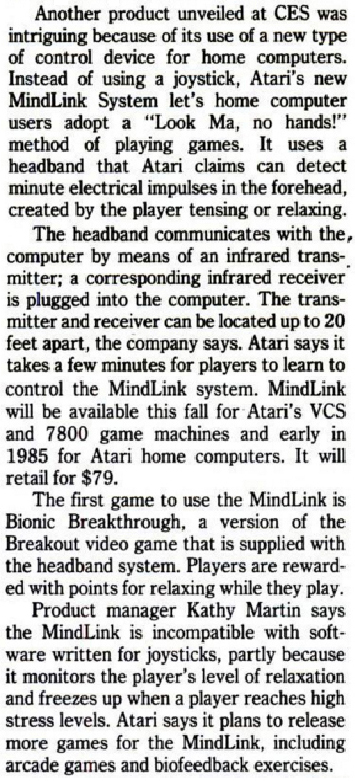
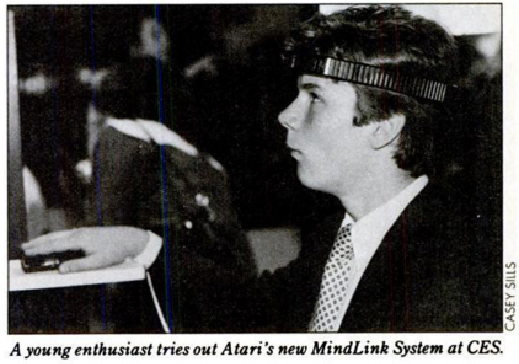
InfoWorld July 9th, 1984 (pg. 35-36).
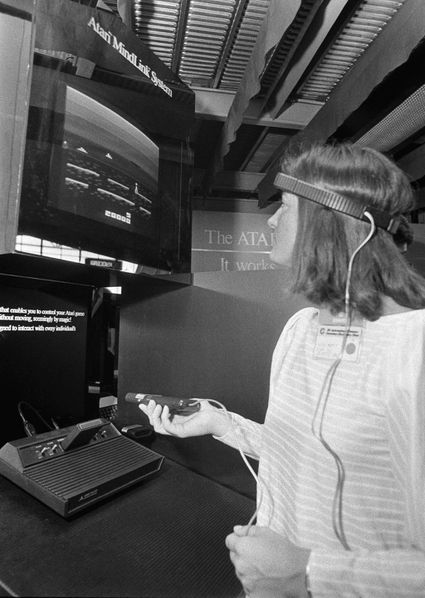
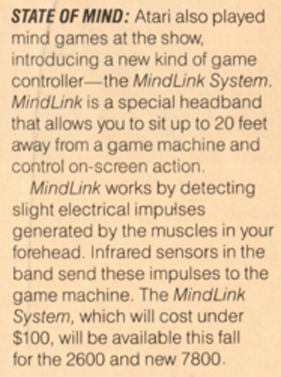
(RIGHT) Forbes June 4th 1984; (LEFT)
Enter
September 1984 (pg. 17)
The MindLink Product Manager was a real nice British guy who's name I can't remember (Ed.: Anthony Jones), who was a friend of Chris Horseman's. He asked me to make the Telepathy prototype. I didn't meet anyone who worked on the MindLink, just the Product Manager, who asked me to do something in a rush. He was in some kind of jam and needed it fast, like in a few days, and dumped a bunch of stuff on my desk. He hung around a lot and offered encouragement, which helped. I had a reputation for getting something done fast. It might not be the best, but at least you'd get something. I thought the MindLink was really dumb at first and too limiting, but after a while I really got to like it. I got good enough that I could turn down the sensitivity to the point that people couldn't see my eyebrows moving, so it really looked like a mind controller. It was strange being perfectly still while playing a game. When I worked on the game, the headset was plugged into the machine. They had a wireless deal, too, because I guess parents have a problem with wiring their kid's heads to something plugged into the wall. But I hardly ever used the wireless thing because it ran on batteries.
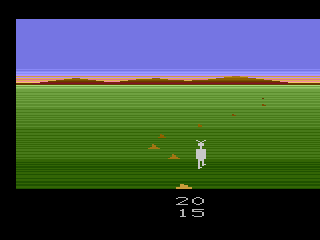
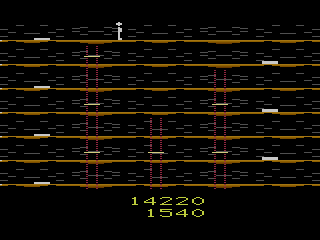

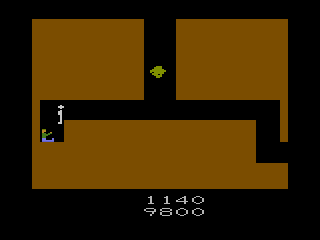
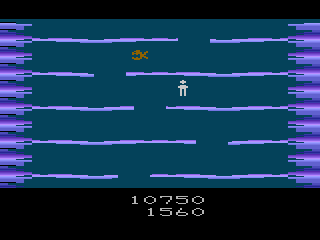
Telepathy was meant to just be a short prototype game for playtesting the MindLink controller. I can't remember using the name Telepathy; that probably came toward the end. I just think of it as the Mind Controller game. I don't think they had anything that ran on the MindLink prior to that. Maybe the hardware engineers had done some software for testing. Come to think of it, they must have, so I must have been given that. There wasn't any special programming hardware-wise. I believe I just read a paddle port.
The unit I used had a (crude) sensitivity dial on it, and that determined how much you had to tense your forehead/eyebrow muscles. At first it could be a real mess for some people, but with a little thinking and practice, you could turn down the sensitivity so much that you could play a game without other people being able to see any movement at all. It seemed like you were controlling the game with your mind. It actually got to be relaxing to just sit there playing a game with no movement, almost like yoga.
The game itself did/could/should do most of the adjusting. For example, in Telepathy, I start out with a simple screen like Kaboom, where gold nuggets come towards you in a pattern. I always start the nuggets on the right side of the screen so I can track what kind of max values I read. That give a basis for what "max" is, and that can be adjusted over and over again. With only a value that ranged from near 0 to some higher number, there was no up, down, left, right, or fire button, so the game had to be designed accordingly. For example, in the mine, if you walk over a hole, gravity can move you down. In the underground river, water flow would move you forward if you swam left or right, which lined you up with an opening. In the mine, you fall down into the shaft to rescue a hurt miner. When you hit a wall and keep walking into the wall, the logic changes to mean "climb up" the wall. So even though you can only move left or right, the player onscreen can be controlled to move up and down, too.
I assume I did the sound for it. The Product Manager was very active on the development, and could have gone out and found an audio engineer and had them do the audio, and then just handed me some files. I wouldn't remember if something like that happened. I could do some things, but I wasn't good at audio. If there's any music in Telepathy, I'd be pretty sure that would have been done by someone else. I don't believe I ever created any music myself, as I don't think I'd have a clue how to.
Development flew because the Product Manager really helped with feedback and encouragement, plus I'd written an "instant assembler" and I had a 500K RAM drive, so I could make a change and see it on the screen in 1-3 seconds. Before that, the turn-around was like 2-3 minutes, so I was doing like 10, 20, 30 times more turns per day. It completely changed the way I programmed. Before that, you kind of had to make 3 or 4 changes, which made finding bugs harder. I could then make a small change and test, and I could try tons more tweaks and experiment way more. Anyways, I sure don't remember Telepathy taking very long - maybe 3 weeks, but I don't think 4 weeks; probably more like 1-2 weeks. And the really weird thing was, I was only working 8-hour days. The concept of working an 8-hour day was very alien while developing a game. It was thanks to the instant assembler system. Previously, most of your time was spend waiting for a build, and I'd spend that time thinking about features, coding tricks, and letting previous lessons sink in. With instant turn-around, that time was removed along with the needed design time. We'd always considered waiting for builds to be "wasted", but I found out it was important. So after 8 hours, or even less, I'd run out of things to implement; I was out of ideas, so I'd have to go home and daydream about the game and hit it again the next day. It was very strange, very different. The PM was pretty sure nothing at all could be done in 1 or 2 weeks. After all, Demon Attack couldn't be done, Pitfall couldn't be done, and Pitfall II certainly wasn't possible.
I got to go to the scheduled playtesting
for it
- one-way glass type
stuff with about 20 suits watching.
The biggest problem I remember is, when we focus tested the unit (at least this
was the only focus test I saw) and all these kids started using the game, it
didn't work. After a bunch
of hardware guys ran around for a while, they figured out the fluorescent lights
were messing up the wireless, so the rest of the testing was done pretty much in
the dark. The unit I'd been
using for development didn't have a RF transmitter; it was wired directly into
the 2600. I assume the RF
problem could have been fixed, but at the time it was a serious issue.
At first, people would have basically 2 moves - 0 and max. That would
cause the player to move across the sc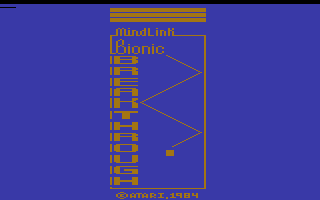 reen
and you could kind of play Telepathy that way, but that could be exhausting,
because to get max, they'd tense their face a lot.
But when you calmed down and actually controlled the player in the middle of the
screen, it was fun and required almost no effort.
I enjoyed using the MindLink a great deal, but I probably logged about 100 hours of use
on it. My muscles were a bit tired after the first couple of hours, but then I figured out it
didn't take hardly any movement at all.
I don't think I played the game much with a stick. It was tweaked specifically
for the MindLink, and it took maybe 30-60 minutes of play with the controller
before a person could start to really play, so it wasn't really a viable product.
We strapped controllers around our legs and arms, so you'd have 4
controllers on you. I forget how that went; we might have been just
screwing around. I recently learned there were 2 more games that were developed
for it - Bionic Breakthrough &
Mind Maze. Looking at it now, Bionic
Breakthrough would have been just to user test the MindLink, and it looks like
the programmer spent too much time on the splash screen - a classic mistake I've
seen made a few times on different projects. Things like splash
screens and Easter
egg initials should all be added toward the end if there's time IMO.
reen
and you could kind of play Telepathy that way, but that could be exhausting,
because to get max, they'd tense their face a lot.
But when you calmed down and actually controlled the player in the middle of the
screen, it was fun and required almost no effort.
I enjoyed using the MindLink a great deal, but I probably logged about 100 hours of use
on it. My muscles were a bit tired after the first couple of hours, but then I figured out it
didn't take hardly any movement at all.
I don't think I played the game much with a stick. It was tweaked specifically
for the MindLink, and it took maybe 30-60 minutes of play with the controller
before a person could start to really play, so it wasn't really a viable product.
We strapped controllers around our legs and arms, so you'd have 4
controllers on you. I forget how that went; we might have been just
screwing around. I recently learned there were 2 more games that were developed
for it - Bionic Breakthrough &
Mind Maze. Looking at it now, Bionic
Breakthrough would have been just to user test the MindLink, and it looks like
the programmer spent too much time on the splash screen - a classic mistake I've
seen made a few times on different projects. Things like splash
screens and Easter
egg initials should all be added toward the end if there's time IMO.
Overall,
I thought it was a pretty amazing piece of engineering.
I'm not sure the actual reason the project was scrapped was because people got
headaches from using it or not. That's the story I've read on Wikipedia,
but that
could be more myth than true. Peoples' hands also got tired when first using a
joystick, but that didn't stop joysticks from being released. People learned you
didn't have to hold them so tight or jam the stick. There were probably
several factors that stopped the MindLink - cost vs. profit, low adoption rate,
specialized games required, etc. Plus it's not like the MindLink was a better
controller by any means. It was just unique. That's a tough business for a
company selling into the mass market. Besides, Atari was just about out of business
by the time the MindLink would have come out, but the headache excuse sounds better.
Jack Tramiel, Atari Corp, and the
ST
When the Tramiels came into Atari, I heard zero talk about games.
When they interviewed me, they asked zero questions about games or work I'd done
on games. Maybe there was some secret group some place, but in the area
where I worked it was zero games 24/7. It was like games had never
existed. I don't remember even seeing an Arcade game in the break room.
I never saw a single person ever play a game at Atari Corp, ever. Not even
a game poster. Nothing. I assume people did play games sometimes,
but I don't remember seeing any. It wasn't common to. There were a
fair number of game designers working on the ST and I don't remember any of us
having even one of our boxed games on display. We didn't discuss games
future or past ever. My impression at the time was Atari Corp was 100%
Jack and company. Nothing from Atari survived other than the name at least
from what I could see. Some of the old Atari may have resurfaced after I
left, don't know.
The Tramiels didn't want anything to do with anything even remotely related to
games in the beginning, just like the rest of us. For that first year or
two after the crash, most people thought video games were gone forever.
You'd be considered imbecile to even consider games. Plus the Tramiels
didn't even have any kind of game background, so even in the heydays they didn't
have anything to do with games beyond helping them to sell hardware. It
seemed normal and very sensible to me in that environment that they had less
than zero interest in games. So that's my basis for thinking the Tramiels
had no interest in games. If they had an interest then buying Atari
certainly would have given them every opportunity to express that interest, and
they didn't. Even when the ST was released, I don't remember a single
person even mention doing a video game for it much less writing a single line of
code. I think it seemed silly to everyone there to consider any game
effort. It wasn't until later when other people showed there was serious
money in games that it all started to look less silly to people at Atari Corp.
I'm pretty sure every single programmer that stayed and worked on the ST were
game programmers. There were a few game programmers that they had stay as
"contractors", and they were charged rent for their cubes. That may have
been an exaggeration by the contractors, I don't know what was in the actual
contracts. But those programmers just used the time to find their next
job. I don't know how long they stayed, I'm guessing a month max. I
don't know why the Tramiels kept them as contractors, perhaps they thought they
could hire them out and take a cut. Maybe there was some royalty
arrangement from previous Atari and the Tramiels wanted them to quit instead of
be fired. No clue. But I'm 100% sure it wasn't to create games for
Atari Corp, or even finish games that were almost done. Maybe some games
to complete some contracts so they wouldn't get sued. I don't know.
I attribute the ST to Jack, though
Shiraz Shivji and a few other engineers certainly made the ST happen.
I would say Shiraz created the ST. But my feeling is Jack drove Shiraz to
create that specific machine with those specific features. But that's only
my impression, as I certainly know zero of what actually went on. I think
the ST hardware or concept was fully formed when Tramiel bought Atari.
There was some chip tweaking, but the concept of a Mac killer was fully formed
IMO.
After the ST shipped, Atari had maybe a dozen game programmer still on staff,
the people who worked on the ST. Atari owned a bunch of great titles,
would have been a breeze to port any of those to the ST. Cost would have
been almost zero since they were already paying us and some of us didn't have
much to do after ST shipped. IMO a few good games on the ST would have
help sell some systems, plus the profit on the games. Or even give away
the games on the system. Not once was this ever suggested even in passing.
The concept of doing any kind of game was completely off the table. So in
mid-85, still zero interest. Instead, we created the rotating cube,
Neochrome, ST Writer, a Finder, etc. Anything but a
game. All those projects we did on our own. My feeling is if we got
caught writing a game we'd probably be shown the door. To say the Tramiels
weren't interested in games is actually an understatement IMO. And I might
add for very good reason. Hindsight is 20-20, but in '84, early '85,
anyone who thought there was money in games was considered insane.
I think the ST was completely a Jack
Tramiel product. I wouldn't say that made it a Commodore or an Atari
product. Working for pre-Tramiel Atari and post was night and day. I
don't consider them to be the same company. I mean, if the manager of the Blackhawks gets booted and buys the LA Lakers, fires 100% of management and 95%
of players and brings in ex-Blackhawks management, hires hockey players to play
basketball, would the LA Lakers still be the LA Lakers? Yeah, but in name
only.
I kind of hate to say the ST "failed", it succeeded in many aspects. But
as a business, it didn't bring in enough profit to keep Atari going as a business,
so it failed in that sense. After the ST dream started to have problems, I
think the Tramiels started to look around for something to salvage and saw they
were sitting on top of one of the best brand names ever, tons of owned rights,
and games were starting to make a come back, it had to be a no brainer...sell
games. Purely a business move driven by limited options. Zero
interest in games other than making money. I wasn't there, but that's my
opinion. Only after the ST failed did they resort to games at what looked
to me like a life line. Even then IMO it was all about leading edge
hardware at low cost and not much about games. Their pitch was all about
RAM, bus, CPU... like they were talking about a laptop.
NES preview
Nintendo was ready to roll
with their NES mid-1983 (Ed.: According to this memo, Nintendo
first approached Atari
in April 1983 while their Famicom was still being developed). Tramiel took over Atari July 1984, so Nintendo
would have been looking for titles for the 1985 launch in North American. The meeting I saw must
have happened July or August, because we were all in Monterey by early September.
To me, it looked like they'd been in a meeting for a long time, and this was the
end, as no one was sitting. This happened at like 7 or 8pm at this
building on the 2nd floor. I remember it being dark outside. Some of us were ushered into
a fancy conference room where a game console was set up, and they told
us the specs for it, which were impressive. I don't know, but I think that
machine was an NES. The people there were from Japan, which is the only
reason I even think this was Nintendo, but I don't remember anyone telling me it
was Nintendo. The Tramiel boys were all there as well, so it was a
high-level meeting. I hardly ever saw Sam or Gary before then.
The other programmers I can remember who were there (and who might have more info) were Jim Eisenstein, Matt Householder, Dave Staugas, and maybe Dave Getreu and Landon Dyer (Ed.: I asked both Matt Householder and Dave Staugas about their recollections of this meeting, but neither recalled anything about it). It seemed like they just brought us in as a kind of a courtesy to Nintendo or whoever this was, to feign interest. The Japanese back then were way into certain social procedures. I wouldn't say Tramiel was stalling; I don't think they were interested even a little bit because they didn't want anything to do with games, but this was too big a company to blow off. We were ushered back out into the hallway and quickly asked a few questions about it, and no one was excited. "What'd you think?" was about as in-depth as it got, and they didn't seem interested in our answers, as no one was excited. That was that. I don't remember any programmers talking about it later. "Why would anyone want to put out a new platform?" was the thinking. The other programmers may have been more interested and played some games, but I wasn't interested even a little. I figured video games were done forever. We were surrounded by abandoned office buildings, and the mushroom clouds from the crash were just starting to dissipate. We were focused on the ST, but Tramiel had less than zero interest in games. For example, they owned all these titles and I don't remember anyone ever suggesting we should port anything to the ST for its release. They just didn't see value in software, like Apple did. Just before I left Atari, I'd written a kind of Finder rip-off for the ST (I did Finder for the Apple IIGS) and a Switcher with the help of the OS guys. Tramiel thought GEM was as good as Mac. Good luck with that. I loved the ST, but thought it deserved better software.
My guess is Nintendo would have been looking for Atari programmers to do NES conversions, because if it was just licenses they were after, I assume Tramiel would have been happy to sell licenses all day long, since he had no plans for them. I don't know the NES very well at all, and I don't know of any Atari games ported to NES, at least in 1985. Now I'm wondering if the reason programmers were marched through the meeting was to just show Nintendo that Tramiel hadn't fired every programmer. Basically, we would have been meat on the hoof. That might also explain why Tramiel had kept some VCS programmers around for a little while, just in case they could make some money off of them, but word was he was charging them rent on their cubes, phones, etc. They were kept separate from the ST project, and I never even met them. I don't know why Tramiel did that.
Final Days
I was so at the tail end as I saw only a little bit of the old Atari. The best
stories I've ever heard were from Dave Staugas. He had some beauties and
was funny as
hell. When Tramiel took over, it was a post-apocalyptic world, with empty multi-story
office buildings and warehouses with absolutely not a single person in them.
The people just left, with millions of dollars of
computer systems all sitting there, still on. The dozen or so programmers
who remained
carried away as much as we could and stacked it like cord wood in our "new
offices" and in the hallway, but Tramiel pretty quickly got a handle on
that. Weird that it never occurred to me to go to the warehouse, wherever the hell
that was, and grab as much of the Final Legacy stuff as I could. Whoever gave me
a copy of it may have gotten it from a warehouse. Instead, we were
going through 40 yard dumpsters and pulling out office supplies and piling up $100k
computer systems in our offices like packrats. I got so many staplers that, in
the past 30 years, I've never had to reload a stapler. I just toss an empty
stapler and use the next one. I don't do a lot of stapling, but geez...
staplers I
save, games I leave. They're freakin good staplers, though; they never jam. Warner may
not have known disk about games, but they knew their office supplies. I also
still have boxes of staples just in case I run out of staplers.
After Atari
I was surprised when Atari got back into games. They'd called me
to do some
debugging work on 7800 Desert Falcon after I'd left. It had a bitch of a bug
and locked up
after running in demo mode for like 10 hours. I got it down to running
stable for 40
hours, but never found the bug, and I wasn't really that interested, either.
I don't
know who the original programmer was or why they didn't finish it. I'm not even sure
I had the source code to use.
I was at CES with some other game
designers when the Atari people were trying to talk us into doing Jaguar games.
This was such an unbelievable concept we didn't even consider the pitch at all.
We didn't talk about it at all, didn't even crack any jokes. I like the
Tramiels a lot;, they do what they do very well and I always found them to be
smart and very nice people. But they and their team weren't into software
of any kind. I did ST Writer on my own because I thought it was insane to
try and sell a computer without a word processor and they had no 3rd-parties
lined up. But to them, they were selling hardware and thought that would be
so compelling others would provide the software. Worked for the VIC-20, so
why not again? Their passion was creating pretty dare good hardware at an
insanely low price. But times changed. Looking at the controllers,
it just seemed pretty clear that this wasn't designed by people who loved games,
or had ever even played a game. Kind of figured the hardware inside wasn't
any better. There were certainly some people there who were into games and
understood games, but too low level to have a real impact on development,
unfortunately.
If you want to write apps and have them published you don't hook your wagon to
non-software people like the Tramiels. Almost every company I ever worked
for were either hardware or software people. Most of them would actively
dismiss the other. Apple embraced both, but even there the two parts were
very separate. So doing games for the Tramiels, at lease for people who
had experience with them, the concept was ludicrous. Creating games is a
creative process; cranking out low cost hardware is more about logistics.
Creating games takes passion. There's no way the Tramiels could ever do
that IMO, they just didn't play games or see why people liked games. That
just never works. And even if they did happen to stumble into a hit game
and did well, guess how the designers would have been treated? As prima
donna towel designers. So there was little reason for experienced game
designers to get on board with the Tramiels. For us, it would have been
lose, lose. There were many more opportunities around that looked a lot better.
That's my personal big picture view,
not saying it's any more true than anyone else's. I'm sure there were memos and
conversations where people could get a different view if they wanted. People say
lots of things to different people for different reasons. To me that isn't as
convincing as bigger picture actions over a long period.
Jack Tramiel did tremendously great things. He just didn't happen to be into
games.
Looking back
I kind of hate to call what we did back in the 80's and what they do today
as both being "games". It's so different. I went back to games in
1994 and did some
larger games at Digital Pictures (Night Trap,
What's My Story?)
and Any River Entertainment, but I didn't really enjoy those kinds of games at
all. The programming was great fun, though.
Companies like Digital Pictures got it. The boss would pop his head in and
ask, "Need
anything?" "Yeah, a bigger monitor." 20 minutes later... "Where do you want it?"
We had meals
every night; anything you wanted. Anything that would take you away from
programming, they eliminated, and we loved that. They had really great game designers,
and great management, but the wrong medium, which I guess is a management fault.
I loved
working there. The guys at Digital Pictures told me that having Night Trap
in the Congressional hearings and banned from stores put that game on the
map. I got to port the PC and Mac versions because of the infamy. There's no such thing
as bad publicity. I would have killed to have a game of mine banned in
Germany.
When I was at Any River, they had an aliens-on-Earth themed game that was about to come out when the infamous alien autopsy was still hot in the press. They started getting questions from the press about whether the game was based on the alien autopsy, and they had a meeting to discuss what could be done. I was like, "Hell yes! The game is absolutely all about the alien cover-up. Aliens are real. We need to do a commercial showing how the alien was killed in our game... yada yada yada. Hire some lobbyist to make sure the CEO is called before Congress." But they were worried about getting negative press. Are you freakin kidding me?! First company I ever worked at where the venture capitalists shut down the company before the money ran out. It was the biggest train wreck ever.
I also interviewed a few years back at Cheyenne Mountain Entertainment to write
tools for Stargate Worlds out here in Phoenix. It was a huge project,
with gigabytes flying everywhere, and more artists than I've ever seen. They had a full-size
Stargate game in
the lobby and the typical, hot, "are they of age?" babe receptionists. It
seemed like
the old days, except everyone was working on the same game.
All I could think of was, why is this all in Phoenix? Tons of people, sharp
engineers, and I love Stargate, so I thought that was a super license. They
really seemed to know their stuff in every way. I would have liked making tools
for them, but the headhunter made a total mess of it, plus the offer was pretty
low, which told me why they were in Phoenix (looking for cheap labor). That's a
red flag to me, so I passed. I've ridden a lot of companies into the beach,
so I can
almost smell death being right around the corner.
Final thoughts
I liked FreeCell and would play it 12-15 hours at a time. FreeCell! That's not
healthy. I had to block it from my browser. So it's a Catch-22; if I liked a game, I'd
have to stop playing it. I go out of my way to not play games for fear of
addiction. I won't play golf or try Altoids, either. My addiction to programming
at least pays the rent... some months.
I don't even have my 2600 anymore. I sold it like years ago at a yard sale. The guy who bought it really lit up seeing the 2600,
as it brought back memories for
him. His wife didn't seem as thrilled. I had what I thought was a high price,
maybe $50, because I would had just as soon keep it. I probably should have told him I
programmed games for it. Maybe he would have paid full price. I got rid of all my Apple
computers. I had a Woz machine. I might still have that. I'm trying to be more of minimalist. If I kept everything I'd worked on, I'd be
buried.
I don't know if this is common knowledge or not but, most game programmers I met
back then were either into audio or visual arts. I forget where but, several us
were sitting around shooting the breeze and someone said something about playing
an instrument and someone else said that they also played an instrument. Pretty
soon we realized everyone there played a musical instrument or had been a painter. I
remember it being a little freaky and us all being surprised. We kind of
wondered if that was why we all did games.
If the concept for Tempest had been focus tested, it would have never been made. After Tempest was out, people could then say they wanted more
games like
Tempest. The axiom remains true. Product development doesn't really have a lot to
do with what people currently want. Steve Jobs never surveyed users. He'd say
something like, "Build what they're going to want, not what they want today."